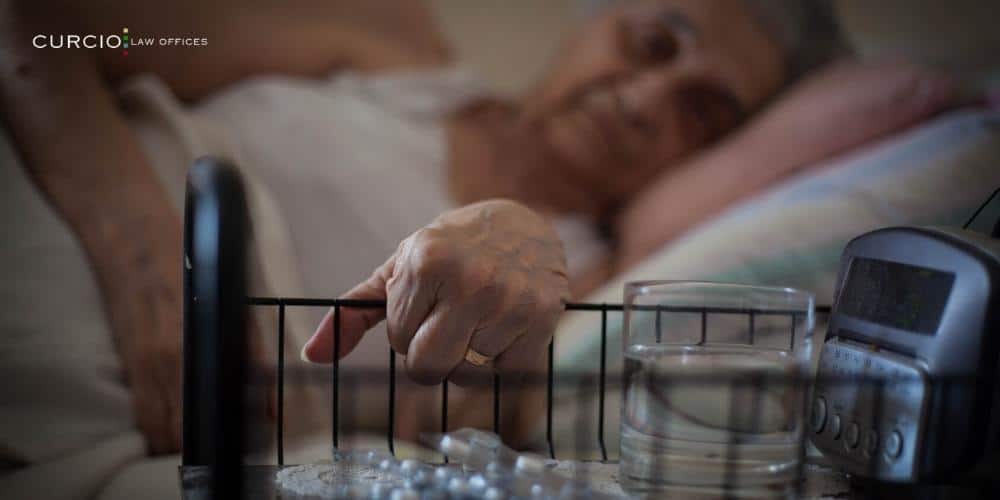CHICAGO NURSING HOME INFECTION LAWYER
PRACTICE AREAS
Tragically, many American nursing homes are breeding grounds for neglect, abuse, and infectious outbreaks. In fact, many nursing home infections are the direct result of neglect and abuse. While common infections are no big deal for the majority of the younger population, they are a big deal for elderly patients in nursing homes. Something as simple as a urinary tract infection (UTI) or a stomach bug can lead to serious infections – and even death – among nursing home residents.
Below, the Chicago elder abuse attorneys at Curcio & Casciato discuss common nursing home infections and infection control measures. Additionally, we explain how frequent infectious outbreaks in nursing homes can be a sign of neglect and abuse.
To schedule a free consultation with our team of experienced Chicago nursing home abuse attorneys, call 312-321-1111 today.

What Are Nosocomial Infections?
Nosocomial infections are viral, fungal, or bacterial infections that are contracted and spread in hospitals and acute care facilities. These types of infections are also called healthcare associated infections (HAI). Unfortunately, HAIs are very common in nursing homes because elderly people tend to have weaker immune systems than the rest of the younger population. So if staff and visitors carry infectious diseases into the nursing home facility without anyone knowing, then residents could easily get sick.
Nosocomial infections also occur due to other reasons like unsanitary medical equipment, negligent medical treatment, poor hygiene, and overall poor health of the patient.
Risk Factors for Nursing Home Infections
Frail elderly persons in nursing homes have a higher risk of developing all sorts of infections compared to the rest of the population. Specific risk factors and complications of immobility include:
- Weakened immune systems
- Old age
- Close living quarters
- Poor hygiene due to mobility difficulties
- Comorbidities
- Poor diet and exercise
- Nursing home neglect and abuse
How Many Nursing Home Infections Occur in the U.S. Every Year?
Approximately 1.5 million elderly Americans live in nursing homes across the nation. Unfortunately, these elderly nursing home residents suffer from about 2 million infections every single year.
Infectious outbreaks in nursing homes have significantly increased over the last decade. With the current prediction that more than 5 million elderly Americans will need nursing home care by the time 2030 rolls around, the number of infections is expected to increase further.
Common Types of Infections in Nursing Homes
There are so many types of bacterial, fungal, and viral infections that can occur in long-term care facilities. The most common types of nursing home infections that we’ll discuss are urinary tract infections (UTI), skin and soft tissue infections, respiratory tract infections, COVID-19, gastrointestinal infections, and sepsis.
Anyone of any age and gender can suffer from urinary tract infections (UTIs). However, these types of infections most commonly afflict women. A UTI is basically when bacteria enter into the urethra and causes an infection. Symptoms include painful urination, an increased urge to urinate, low back or pelvic pain, blood in the urine, and fever. Without timely treatment, a UTI can lead to a kidney infection or UTI delirium. Elderly people are at a higher risk of suffering other complications from a UTI, such as kidney failure and sepsis.
A UTI is a common infection in a nursing home setting because of various factors. The most common reason why nursing home residents suffer from frequent UTIs is that many of them need catheters. Catheters are tubes placed into the bladder to help immobile or incontinent patients urinate. If the catheter isn’t clean enough, this could cause an immediate infection. Additionally, if a catheter stays in place for days at a time, this increases an elderly patient’s risk of developing excess bacteria in the urethra.
Another reason why UTIs in nursing homes are so common is due to poor hygiene and infrequent diaper changes. If an elderly person has to sit in their own waste for several hours, this can certainly lead to a UTI.
Nursing home facilities can help prevent UTIs in their patients by improving their hygiene, helping them walk to the toilet frequently enough so they don’t need catheters, and changing diapers frequently.
Contact our Chicago nursing home UTI lawyer for more information.
Skin and soft tissue infections are also a major problem among nursing home residents. The most common type of soft tissue infection is bedsores (pressure ulcers), which occur when elderly residents lay in one position for more than a few hours. The pressure cuts off the skin’s blood supply when someone sits or lays in one position for too long.
There are four stages of bedsores, outlined by pressure ulcer staging, with the first stage being the most minor and the stage four bedsores being a severely infected pressure ulcer that resembles a gaping hole in the skin. The stage four bedsore life expectancy for a nursing home patient is grim without immediate treatment.
Nursing home residents have a very high risk of developing pressure ulcers because of immobility, poor hygiene, and poor nutrition. Without prompt treatment, infected pressure ulcers can easily become a life-threatening infection for an elderly person. Our Chicago bed sores attorneys have extensive experience with these claims.
Other common types of chronic wound infections and skin infections in nursing homes include:
- Diabetic wound infections
- Herpes zoster/simplex
- Cellulitis
- Scabies
- Necrotizing fasciitis
- Vascular ulcers
- And more
Staff can help prevent these skin infections through good hygiene, helping patients walk around multiple times a day, rotating patients in their beds every few hours, and ensuring that all patients eat nutritious meals.
Our Chicago malnutrition lawyers can help if you believe the lack of food or improper nutrition led to the infection
Methicillin-resistant staphylococcus aureus (MRSA), also called a “Superbug,” is a staph infection resistant to many common types of antibiotics. MRSA generally begins as a skin or soft tissue infection and then spreads to other parts of the body, especially if it’s not treated promptly.
According to the Centers for Disease Control and Prevention (CDC), as many as 2 out of every 100 people carry MRSA, and this can include staff in nursing facilities. Carrying the virus is not the same as being infected by the virus. If a staff member is a MRSA carrier and tends to an elderly person’s bedsore, the elderly person could easily develop a MRSA infection in their open wounds. Urinary tract infections could even turn into severe MRSA infections if there’s negligent medical care happening.
Due to old age, comorbidities, and weakened immune systems, nursing home residents are at a higher risk of suffering from a variety of MRSA complications, such as blood poisoning, sepsis, kidney failure, pneumonia, bone and joint infections, and even death.
Our seasoned Chicago MRSA lawyer has extensive experience with these claims.
Lower respiratory tract infections, such as pneumonia, cause the most deaths among nursing home residents. A respiratory tract infection can start off as a fairly minor condition – such as an influenza virus or the common cold – and quickly escalate to a serious condition, such as:
- Respiratory syncytial virus (RSV)
- Pneumonia (streptococcus pneumoniae is one of the most common types of nosocomial pneumonia infections)
- Aspiration pneumonia which is a lung infection that occurs when elderly people inhale food, water, or saliva
- Bronchitis
- Laryngitis
- Tuberculosis
Respiratory infections are typically passed from visitors and staff to nursing home residents. Then, if residents aren’t properly quarantined, they can pass respiratory infections to each other. Additionally, if staff members don’t make sanitization of high-touch surfaces a priority, nursing home residents can contract a respiratory tract infection that way too. Lastly, if nursing home residents have poor oral hygiene, their risk of developing lower respiratory tract infections increases significantly.
Gastrointestinal infections are also a common problem among nursing home residents because they produce much less gastric acid than the rest of the younger population. This naturally increases their risk of developing infectious gastroenteritis (AKA: norovirus) and other gastrointestinal infections like clostridium difficile (c-diff).
The main symptoms caused by norovirus outbreaks and clostridium difficile infections are nausea, vomiting, diarrhea, and fever. Infectious diarrhea and vomiting creates a huge risk of dehydration and malnutrition among elderly people.
Gastrointestinal infection prevention in nursing homes can be tough because of how contagious these viruses are. They can spread through food, water, and direct contact.
Our Chicago nursing home sepsis attorneys understand that sepsis in nursing homes can result from many of the aforementioned bacterial, viral, and fungal infections. Basically, this condition is the body’s extreme response to a serious infection. Sepsis is considered a life-threatening condition that can easily cause death among elderly people. People over the age of 85 are 5 times more likely to die from severe sepsis than those ages 65 to 74.
What are the three stages of sepsis?
The first stage has the lowest mortality rate, and the last stage has the highest mortality rate. That’s why nursing home staff members must recognize the initial symptoms of sepsis in their elderly patients and treat them promptly.

Treating and Preventing Nursing Home Infections
There are many types of nursing home abuse.
Most infected residents in nursing homes receive antibiotics. However, high rates of infections in nursing homes are creating antibiotic resistance and antimicrobial resistance. In other words, many nursing home residents are now suffering from infections that aren’t responding to antibiotic treatment. Nursing homes are responsible for antibiotic stewardship for this reason.
For example, MRSA is one of many antibiotic-resistant organisms. Additionally, clostridium difficile infections are often the result of frequent antibiotic use. That’s because antibiotics can greatly disrupt gut bacteria, especially in older individuals. Many nursing home residents who receive antibiotic therapy for Clostridium difficile infections suffer a secondary infection. In cases like this, healthcare providers may have to resort to a fecal transplant or probiotic supplementation to balance out the gut bacteria and resolve the issue.
Infection control practices should be a priority in all nursing homes due to the rise in antibiotic-resistant organisms. The best infection prevention practices are vaccinations (such as the COVID-19 and influenza vaccinations), proper hygiene, adequate nutrition and exercise, sanitized medical equipment, quarantines, and no nursing home neglect or abuse.
How Are Nursing Home Infections a Sign of Nursing Home Abuse?
Infection prevention often directly correlates with nursing home neglect and abuse. If staff members regularly neglect their elderly residents, the residents will suffer from poor hygiene, more frequent falls and injuries, undetected infections, unsanitary environments, and overall poor health. Not only do neglect and abuse create a poor quality of life, but they also dramatically shorten the lifespan of elderly residents. If you notice that your elderly loved one is suffering from numerous infectious disease outbreaks in their skilled nursing facility, our Chicago elderly abuse attorneys can help you file an elder abuse lawsuit. Or if the lack of attention to the infection led to a serious fall, our Chicago nursing home falls attorney can help you with a claim.

Chicago Nursing Home Infection Attorney
Nursing home residents are some of the most vulnerable people in our population. Most of them can’t speak up about their experiences and fight for themselves due to mental and physical disability. That’s why Chicago’s top elder abuse attorneys are so passionate about fighting for the rights of those in nursing facilities. If your elderly loved one is directly suffering from poor infection management in their nursing home, you can pursue legal action. Call a Chicago personal injury lawyer at Curcio & Casciato today at 312-321-1111 to schedule a free consultation.


